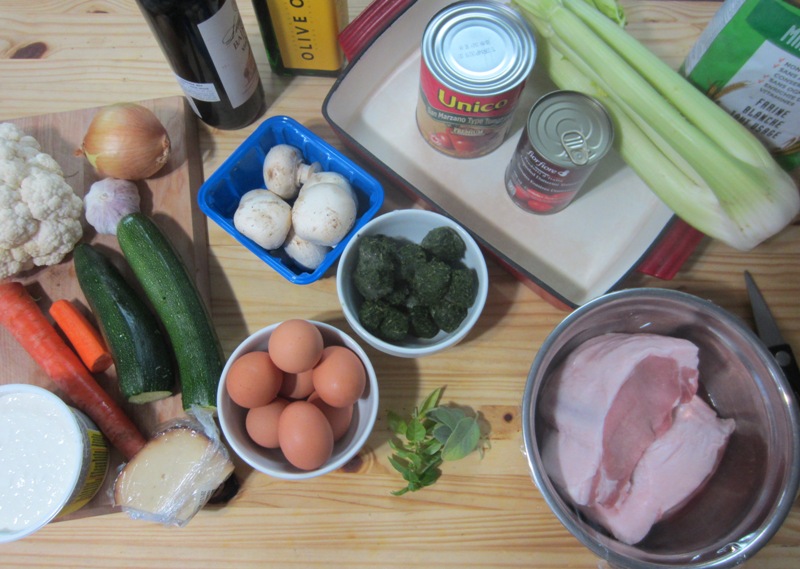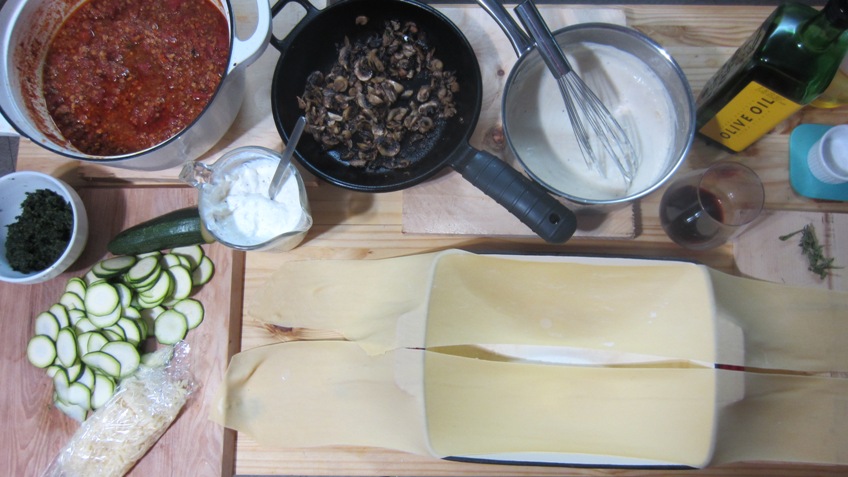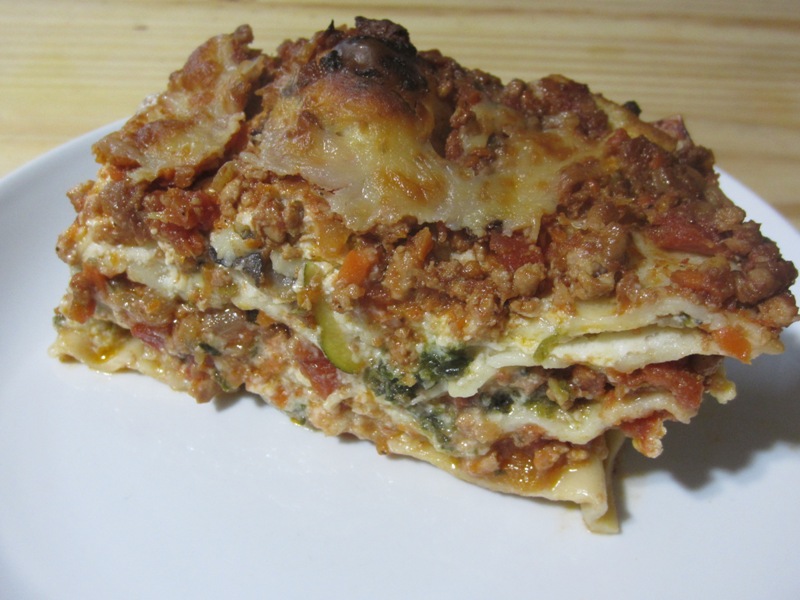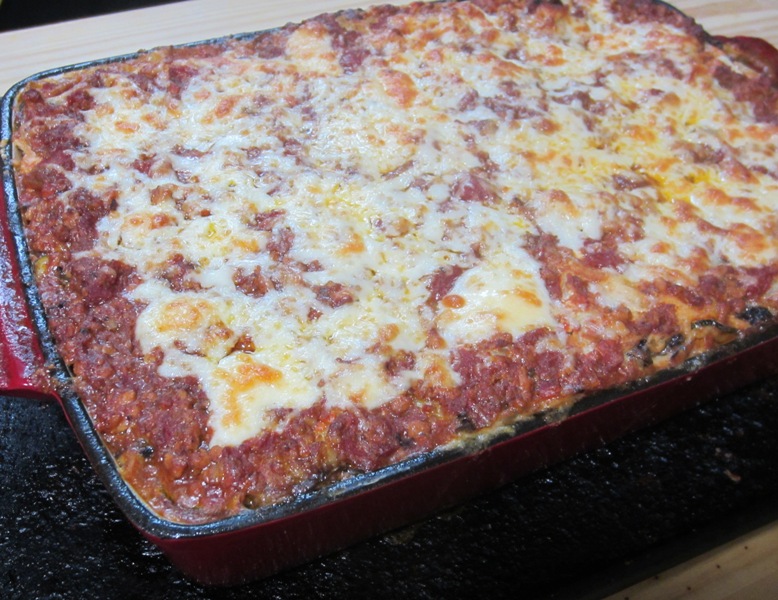So it’s Thanksgiving today in Canada. Virus woes have put a crimp in dinner gathering plans the world over so for the first time in decades, I’m not cooking the usual fare today. I’m sure I’ll correct that omission when the American version of the holiday rolls around in a few weeks. In the meantime, I woke up between kitten feedings with a serious lasagne craving a few nights ago and spent a weekend day putting in the time for a really good pan’s worth.
Lasagne Notes 2020-10-10
There’s a lot of really substandard pre-made lasagne on the market. Avoid them. Get in touch with your inner Italian grandmother instead.
Not really a recipe here because lasagne is fairly democratic in makeup. Use what you have particularly in the seasonal vegetable department. Covered in great sauce and shoved between fresh pasta most anything will work.
For measurements simply look at the size of your pan. I usually over-estimate because a wee pan of ‘scrap lasagne’ will feed me during the agonizing cooling time of the main dish.
For that matter, why not make a spare pan while you’re going to the trouble? A disposable foil pan works fine to contain it in the freezer and with some dimensional planning you can, on some cold winter night of the future, simply tip that brick of delicious into your good cast iron pan for baking. Tests show that freezing, especially in a good vacuum seal, suffers almost no ill effects on taste for several months but do call time on them after a year even in the best of circumstances. Note that this is not to say that ready-made retail frozen lasagne is anywhere near a substitute for your carefully chosen quality ingredients at home. I’ve tried to ‘enhance’ ready-made with all manner of tricks (extra cheese for a start) with absolutely zero success.

Make your own pasta sheets. Seriously. One egg per 100g flour. Specialty flour not necessary. No faffing about with separating eggs. No oil, no salt. Nothing. It simply doesn’t need to be any more complicated. A 9” x 13” pan of lasagne will likely need three times that measure. You can mix all at once but only try to roll out about a third at a go unless you have some really tall places to hang pasta banners for drying.
Yes, if you wish you can use only yolks but that will average two per 100g flour. Save advanced pasta additions like herbs or sun-dried tomatoes for other recipes. There’s already plenty of flavour going on in a lasagne.
Since you’re making your own, you’ll need a pasta roller. Thirty bucks online for a manual machine will pay for itself in a few month’s worth of pasta when you realize just how EASY it makes the process. If you have a set of helping hands in the house (spouse, kid, very dexterous cat, etc.) you’re all good. If you’re solo, it’s worth getting a powered version, e.g. an attachment to your stand mixer for around a hundred bucks, to give yourself a third hand. You have a lifetime of pasta to get your payback.
You don’t need to pre-boil freshly made pasta sheets before assembly however you do need to let them dry for a few hours beforehand. Make them in the morning and hang them about to dry while you do the rest of the prep. Let them cook in the lasagne. They soak up more flavour that way and seem to hold their structure better in the bargain. Improvise drying racks with wooden utensils perched across big pots, on dormant appliances, etc. Make it look like an Italian alley full of pasta laundry in the sun.
Courgettes (zucchini, squash, whatever you call them in your neighbourhood) are the perfect addition to any lasagne for flavour and structure. Just ensure you slice them very thin and layer them in uniformly. No other prep necessary.
If you’re using meat in your sauce, get a single cut of meat and grind it yourself. The difference is remarkable. If you only have pre-ground mince available, I’d say skip it and make a more interesting vegetable version. Roast some peppers, add more exotic mushrooms, go nuts with pesto. There’s just no need for pale ‘filler’ meat when you have so much flavour going on otherwise.
Start your tomato sauce (or ragu) simmering right after your pasta duty is done. It needs not only the long-ish cook time but some extra resting time will help the flavours coalesce. Obviously this is a place to use the best ingredients (good tinned tomatoes are fine) but really spend some time on composition. Start with a great soffritto (finely chopped or grated carrots, onion, celery sautéed gently in oil until soft) and load in most anything else from the garden that needs some extra cook time. Cauliflower works a treat.
Certain vegetables need extra attention to be their best. Aubergines roasted separately in the oven for example. Ever popular spinach needs separate cook time to reduce the moisture and get some seasoning help like freshly ground black pepper and/or nutmeg. Frozen works in a pinch as long as it hasn’t been lurking in the freezer too long but if that’s your only option, squeeze the heck out of it and cook it in a pan until the steam stops rising. It can be as much as half water.
Mushrooms too really should be cooked separately to reduce moisture and concentrate flavour. Not until they’re crispy mind you but some good golden colour. A mix of butter, olive oil, and fresh thyme is my preferred approach. You DO have fresh herbs growing in your windowsill, right? Pot, dirt, plant, water weekly. Done.
I think both ricotta and cottage cheese are perfectly acceptable layers in lasagne despite the raging debate therein. My opinion is that both should be full fat versions and both should be blended smooth with a cheap immersion blender. Perfect opportunity again to season properly with black pepper, parsley, garlic, good salt, or whatever else your taste brain thinks appropriate. Some people add eggs there. Personally I don’t.
You could certainly use pure shredded or grated cheese for layers. Parmesan is a salty winner. Mozzarella can be a melting masterpiece. For my money however I make a quick mornay sauce (béchamel + cheese) so I have a chance to control the seasoning and give myself more volume to spread evenly on the layers. Again, nutmeg and black pepper are my favourites but this is a good place to experiment. Sweet roasted garlic for example. Or add a suitable vegetable like braised leeks or artichoke blended to your desired texture with an immersion blender right in the pan. Make the sauce perhaps slightly thicker than you might otherwise for good layer building.

You really want as many layers as possible for showstopper lasagne. I’ve owned great-for-lasagne-baking cast iron dishes for many years but in an ideal world they would be about half an inch deeper. Whatever you’ve got, use a bit less filling than you expect for each layer to give you room for more of them. I always start and end with a sauce layer.
Some cooks assemble then chill their entire lasagne before baking. I have no problem with this, I just don’t do it. I’m told it’s for better layer retention but I’ve not had problems in that department. I suspect my homemade pasta and lack of a preboil saves me from tragic layer collapses. Maybe for a magazine photo shoot or some such I’d spend a few hours chill time but otherwise I’ve not got that level of patience when I’m hungry for lasagne.
The ‘top’ requires a bit of thought. I cook lasagne at a slightly lower temperature than many (165C, 330F) to allow for longer time (90 minutes) and thus, a bit more evaporation during the bake. Because of that I don’t want any final cheese flourish getting in the way for most of the bake. I cover with foil to help bake the center layers then at halftime remove it and give the whole pan a spin for even baking. About fifteen minutes from the end I add any cheese I want on top and sometimes (carefully) employ the broiler in the final minutes for golden, bubbly glamour.
You MUST COOL YOUR LASAGNE. I know the wait hurts but the flavour will benefit greatly not to mention the layers will have time to set better. Cutting into piping hot lasagne usually results in what can only be called a hot mess. Give it an hour on the counter – it will still be plenty hot if you used cast iron – take the tiny piece you can’t stand to wait for any longer, then give it another hour (or two) further cooling before eating half the pan. I know you’re not going to do this the first time but try it on your second pan and you’ll taste the benefits. Don’t believe me? Save that last corner piece overnight in the fridge and thank me tomorrow.
Did I mention to make your own pasta? I mean it. It’s NOT that hard or time consuming. Now get to it. GREAT lasagne isn’t that far away. -th v.2.3


